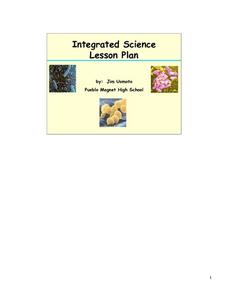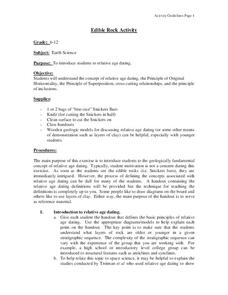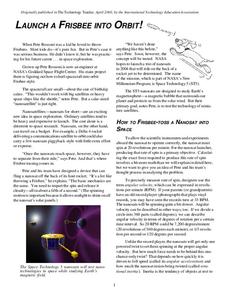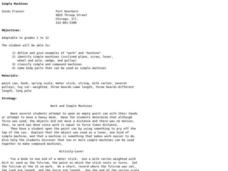Curated OER
Food Chain
Third graders role-play various organisms from a food chain to illustrate how a food chain works. In relay style, 3rd graders fill their cups (stomachs) and, in turn, fill a larger organism's cup (stomach) to visualize the importance of...
Curated OER
Biotechnology
A continuous cascade of information comes through this PowerPoint on biotechnology. The topic is defined, a history is presented, and basic genetic engineering techniques are explained. The topic is covered in an objective manner,...
Curated OER
Scientific Method Unit: Bacteria
Students discover how to apply the steps of the inquiry process through the study of bacteria. Working in groups of four, they cooperatively read an article about bacteria and complete a graphic organizer. Group members share with others...
Curated OER
LESSON #2 SAFETY UNIT: Real-life reading selection
When studying pollution and the environment, you can use this activity as an enrichment. Safety-conscious learners read a 2005 article about an ammonia leak from a Kentucky fast-food product plant. They work in small groups to discuss...
Curated OER
All Ears for Adaptation
Students discuss different characteristics that enable animals to adapt to their environments. They work in pairs with one partner standing about one foot behind the other partner and cup their hands around their ears with palms forward....
Curated OER
BioTechnology
The concept of electrophoresis and how it can be used to track sections of DNA that have been spliced is introduced in this slideshow. There are a few grammatical and spelling errors, but overall the slides are nicely presented.
Curated OER
Breathing
When learning about the respiratory system, how do learners know what is important? One way is to use a self-assessment or study like the one found here. While the formatting could use some work, the concepts are solid. Depending on your...
Curated OER
Edible Rock Activity
Who knew Snickers® could be used to teach science? Give your budding earth scientists a chance to explore the Law of Superposition, in addition to a well-earned snack.
Curated OER
What Is Important to Me?
Students respond to prompt with awareness of personal value of possessions. They list the criteria used to determine worth and value. They listen and ask questions or add comments and check their own measures of value with those the...
Curated OER
Are Our Chemical Measurements Accurate or Precise?
What is the difference between accuracy and precision? This worksheet has students define the terms accuracy and precision, and compare bulleye diagrams to find examples of both. Students analyze given data and determine the accuracy and...
Environmental Protection Agency (EPA)
Teachers' Guide to Using A Day In the Life of a Drop
Hydrology hopefuls learn about their local watershed. Through discussion and online interactives, they see that their habits affect the water supply. The lesson concludes with a pledge to filter out bad water usage habits. It makes a...
Wind Wise Education
Can Wind Power Your Classroom?
Can you power this? Individuals do an energy audit for the classroom to determine the amount of electricity needed to power it. Using either live data or sample data from wind turbines they decide whether it would power the classroom....
International Technology Education Association
Launch a Frisbee into Orbit!
How fun it must be to play Frisbee in space! That is just what a NASA engineer gets to do, and you can learn how, too. Follow the instructions provided in this informational article to create your own satellite launcher. Afterward,...
Ask a Biologist
Neuron Anatomy Activity
Reinforce the neural connections in the brains of your young biologists with a simple anatomy worksheet. Looking at the provided diagram of a neuron, students are asked to correctly identify and describe the function of...
Curated OER
Applied Science - Technology (2A) Lab
Second graders experiment with simple machines. In this machine lesson, 2nd graders go to different labs to see examples of a lever, inclined plane, wedge, pulley, gears, and wheel and axle. They discuss how a machine makes work a lot...
Curated OER
Indianapolis 500 Unit-Science
Fourth graders access prior knowledge of simple machines to build a car. In this car design lesson, 4th graders create and race their cars. Students evaluate what was good and bad about their designs. Each car will incorporate a...
Curated OER
What Parts Are There to a Plant?
Students identify and sort plant parts through hands-on activities and group discussions and then work with magnifying lenses and tape measures to document their observations on a student sheet.
Curated OER
Working with Questions
Students explore questions in a scientific context. They consider what makes questions testable. After reading short scenarios, students come up with their own testable questions about the reading.
Curated OER
What's a Resistor?
Students determine what a resistor does as they construct parallel circuits. In this circuitry lesson, students experiment with batteries, alligator clips, a resistor and a three-way switch to find out what a resistor does. They continue...
Curated OER
What on Earth?
Second graders investigate the different living and nonliving things they can find on Earth. In this life science lesson plan, 2nd graders record their observations as they dig into the soil. They examine them under the magnifying glass...
Curated OER
What's New With Dinosaurs?
Students examine how scientists are at odds on whether or not dinosaurs were warm or cold blooded. In this dinosaurs instructional activity students divide into groups and research the evidence that supports each side.
Curated OER
Testing for Vitamin C in Different Drinks and Foods
Students examine the importance of vitamin c in their diets and the sources that it comes from. In this vitamin lesson students complete hands on activities, interpret data and make a bar graph.
Curated OER
Simple Machines
Students investigate what simple machines are and how they work. In this simple machine lesson, the students create simple and compound machines and test each machine's ability to perform a task. Students compare simple machines to...
Curated OER
Plant Science: merit badge
In this plant science worksheet, students answer short answer questions about plant science. Students complete 7 questions to get their merit badge.























